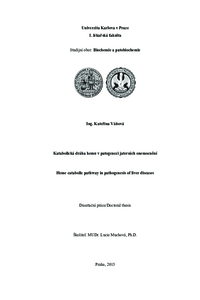Katabolická dráha hemu v patogenezi jaterních onemocnění.
Heme catabolic pathway in pathogenesis of liver diseases
dizertační práce (OBHÁJENO)

Zobrazit/
Trvalý odkaz
http://hdl.handle.net/20.500.11956/65479Identifikátory
SIS: 153819
Kolekce
- Kvalifikační práce [4449]
Autor
Vedoucí práce
Oponent práce
Brůha, Radan
Neužil, Jiří
Fakulta / součást
1. lékařská fakulta
Obor
-
Katedra / ústav / klinika
Ústav lékařské biochemie a laboratorní diagnostiky 1. LF UK a VFN
Datum obhajoby
16. 6. 2015
Nakladatel
Univerzita Karlova, 1. lékařská fakultaJazyk
Čeština
Známka
Prospěl/a
Předkládaná práce se zabývá rolí katabolické dráhy hemu v patogenezi vybraných jaterních onemocnění. Cílem bylo objasnit, zda může modulace enzymu hemoxygenázy (Hmox) a vznikajících produktů- zvláště oxidu uhelnatého (CO) a bilirubinu- ovlivnit vznik a průběh zánětlivých a cholestatických pochodů v játrech. U modelu zánětu vyvolaného podáním endotoxinu se nám podařilo prokázat, že indukce hmox1 chrání jaterní tkáň před hepatocelulárním poškozením. Podávání CO potkanům s cholestázou indukovanou endotoxinem mělo za následek snížení exprese zánětlivých cytokinů v jaterní tkáni a zároveň zabránilo snížení exprese jaterních transportérů, což vedlo k významným hepatoprotektivním účinkům. Dále jsme jako první popsali in vivo distribuci a eliminaci inhalovaného CO ve tkáních potkana. V in vitro experimentech a u modelu extrahepatální cholestázy jsme sledovali roli bilirubinu v ochraně hepatocytů před oxidačním poškozením. Rovněž jsme prokázali, že indukce hmox1 zvyšuje expresi jaterních transportérů u modelu cholestázy ...
This thesis focuses on the role of heme catabolic pathway in the pathogenesis of selected liver diseases. The aim was to clarify if the modulation of heme oxygenase (Hmox) and its catabolic products - especially carbon monoxide (CO) and bilirubin - affected the development and progression of liver diseases, focusing on inflammatory and cholestatic pathways. Firstly, we discovered that the induction of hmox1 prevented hepatocellular damage in endotoxin-induced inflammation. Furthermore, administration of CO in vivo in early-phase of endotoxin-induced cholestasis decreased the inflammatory cytokine production in the liver and simultaneously prevented downregulatory effect of cytokines on hepatocyte transporters resulting in hepatoprotection. For the first time, we characterized in vivo tissue distribution and elimination of inhaled CO in rats. In vitro experiments and the model of extrahepatic cholestasis revealed the significant role of intracellular bilirubin in hepatocellular protection against oxidative damage which accompanies cholestatic disorders. Last but not least, hmox1 induction by heme increased hepatocyte transporters expression and subsequently stimulated bile flow participating in conferring protection against estrogen-induced cholestasis. Presented results demonstrate that the heme...
